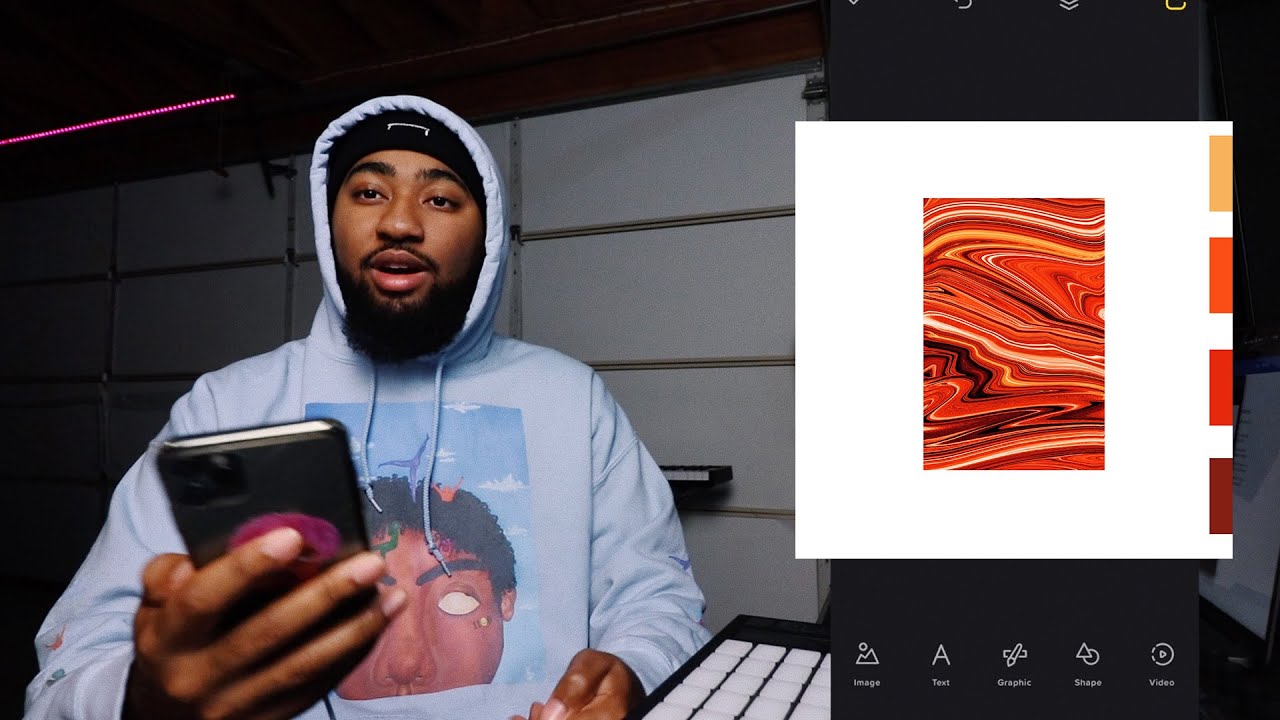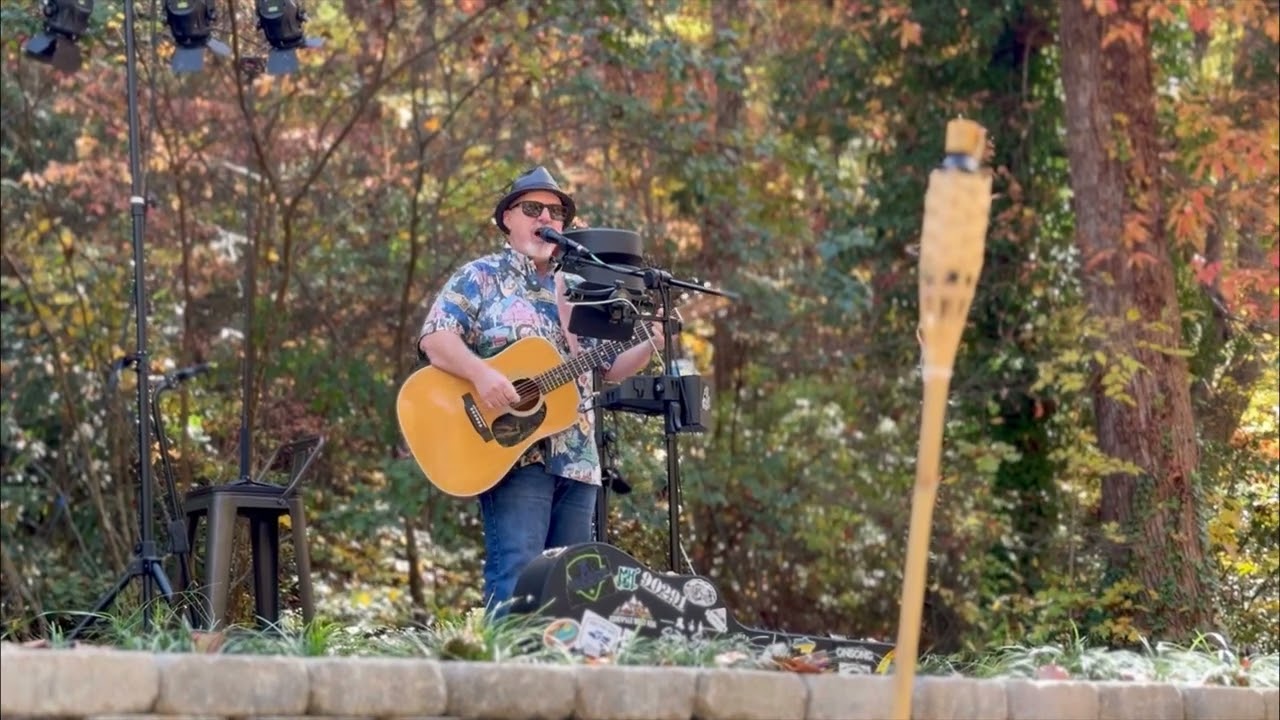Home>Production & Technology>Cover Song>How To Do A Cover Song On Facebook


Cover Song
How To Do A Cover Song On Facebook
Modified: February 17, 2024
Learn how to do a captivating cover song on Facebook and engage your audience. Discover tips and tricks to make your cover song stand out from the crowd.
(Many of the links in this article redirect to a specific reviewed product. Your purchase of these products through affiliate links helps to generate commission for AudioLover.com, at no extra cost. Learn more)
Table of Contents
- Introduction
- Step 1: Choose the Right Song
- Step 2: Research Copyright Regulations
- Step 3: Arrange the Song
- Step 4: Rehearse and Prepare
- Step 5: Set Up Recording Equipment
- Step 6: Record the Cover Song
- Step 7: Edit and Enhance the Recording
- Step 8: Create an Eye-catching Thumbnail
- Step 9: Write an Engaging Caption
- Step 10: Upload the Cover Song on Facebook
- Step 11: Promote Your Cover Song
- Step 12: Interact with Your Audience
- Step 13: Respond to Comments and Feedback
- Step 14: Monitor Copyright Concerns
- Conclusion
Introduction
Cover songs have become a popular way for artists to showcase their talents and pay homage to their favorite songs and artists. With the rise of social media platforms like Facebook, it has never been easier to share your cover songs with a wide audience and gain recognition for your musical abilities. Whether you are a seasoned musician or just starting out, Facebook provides a platform to connect with fans and showcase your unique interpretations of beloved songs.
In this article, we will guide you through the process of doing a cover song on Facebook. From choosing the right song to promoting your cover and handling copyright concerns, we will cover all the essential steps to ensure your cover song gets the attention it deserves.
Doing a cover song on Facebook can be a rewarding experience that not only helps you build an online presence but also allows you to share your passion for music with others. So, let’s dive in and explore the steps to create an engaging cover song on Facebook, shall we?
Step 1: Choose the Right Song
Choosing the right song is crucial when doing a cover on Facebook. You want to select a song that resonates with you and showcases your musical style and abilities. Here are a few things to consider when choosing a cover song:
- Personal Connection: Look for a song that holds meaning for you personally. Whether it’s a song that brings back fond memories or a track that relates to your own experiences, a personal connection will help you bring authenticity to your cover.
- Suitability for Interpretation: Consider songs that can be reimagined or given a unique twist. While it’s tempting to choose a popular hit, putting your own spin on a well-known song can help you stand out and showcase your creativity.
- Audience Appeal: Keep in mind the preferences of your target audience. While it’s important to stay true to your musical style, selecting a song that resonates with your potential listeners can help attract more viewers and engagement.
Remember, the goal is to captivate and engage your audience, so choose a song that will make an impact and leave a lasting impression. As you explore different songs, make a shortlist of potential covers and listen to them critically. Consider how well the song showcases your vocal range, instrumental skills, and overall musicality.
Furthermore, it’s important to ensure that the song you choose is within your capabilities as an artist. Be realistic about your vocal range and the instrument(s) you can confidently play. If needed, make adjustments to the key, tempo, or arrangement of the song to suit your strengths.
By carefully selecting the right song, you set the foundation for a successful cover song on Facebook. The song should speak to your passion and creativity while resonating with your audience. So, take your time and find that perfect song that will showcase your talent and captivate your viewers.
Step 2: Research Copyright Regulations
Before proceeding with your cover song on Facebook, it’s important to understand and comply with copyright regulations. Copyright laws protect the original works of artists, including songs and compositions. By doing a cover song, you are using someone else’s copyrighted material, and it’s essential to be aware of the legalities involved.
To ensure you stay on the right side of the law and prevent any potential copyright infringement issues, follow these steps:
- Identify the Song’s Copyright Holder: Determine who owns the copyright to the original song. This information can usually be found in the song’s credits or through online databases such as ASCAP, BMI, or the Harry Fox Agency.
- Obtain the Necessary Licenses: Depending on the jurisdiction and the intended use of the cover song, you may need to obtain licenses to legally perform, record, and distribute the cover. Licenses can be obtained through agencies like the Harry Fox Agency (for mechanical licenses) or performing rights organizations like ASCAP, BMI, or SESAC (for performance licenses).
- Check for Song-Specific Limitations: Some songs may have specific limitations or requirements for covers, such as obtaining permission directly from the songwriter or adhering to certain guidelines. Be sure to check for any song-specific limitations and guidelines before proceeding.
It’s important to note that not all cover songs require licenses, especially if they fall under “fair use” or “public domain” categories. However, it’s always better to err on the side of caution and obtain the necessary permissions and licenses to avoid any legal issues down the line.
If you’re unsure about the copyright status or licensing requirements for a particular song, consult with a legal professional or a knowledgeable music industry expert. They can help guide you through the process and ensure your cover song complies with all applicable copyright regulations.
By thoroughly researching copyright regulations, obtaining the necessary licenses, and following proper procedures, you can confidently move forward with your cover song on Facebook, knowing that you are respecting the rights of the original creators and protecting yourself from potential legal issues.
Step 3: Arrange the Song
Arranging the song is a crucial step in creating a unique and compelling cover on Facebook. The arrangement involves reimagining the original song’s structure, instrumentation, and style to reflect your artistic vision and showcase your creative abilities. Here are some tips to help you with the arrangement process:
- Listen to Different Versions: Take the time to listen to various covers and interpretations of the song you’ve chosen. Analyze how different artists have approached the arrangement. This will help you gather inspiration, identify what works well, and determine what you’d like to incorporate or change in your own arrangement.
- Consider Your Musical Style: Infuse the song with your unique musical style or genre. Whether it’s adding a jazz twist to a pop song or incorporating acoustic elements into a rock anthem, choose an arrangement that aligns with your artistic identity and sets you apart from other covers.
- Experiment with Instrumentation: Explore different instrumentation options for the cover. This can involve adding or removing instruments, changing the arrangement of the chords and melodies, or even incorporating electronic elements or loops. Get creative and experiment with different sounds to give your cover a fresh and engaging feel.
- Focus on the Vocal Performance: Consider how you can showcase your vocal range and abilities in the arrangement. Experiment with different vocal harmonies, ad-libs, and techniques to make the cover truly your own. The vocal performance should be a highlight of your cover and help you connect with your audience on an emotional level.
- Maintain the Essence of the Original: While it’s important to put your own spin on the song, remember to still maintain the essence of the original composition. Pay homage to the song’s core elements and melodies while adding your unique touch to create a captivating and recognizable cover.
During the arrangement process, don’t be afraid to try new things and take risks. Your goal is to create an arrangement that stands out and captures the attention of your audience. Once you have finalized the arrangement, practice it multiple times to ensure a polished and confident performance.
Arranging the song allows you to showcase your creativity and musicality. By putting your unique stamp on the cover, you can create a memorable rendition that resonates with your audience and makes your cover stand out on Facebook.
Step 4: Rehearse and Prepare
Rehearsing and preparing for your cover song on Facebook is crucial to ensure a polished and impressive performance. Here are some essential steps to help you effectively rehearse and prepare:
- Mastery of the Song: Familiarize yourself with the arrangement and ensure you have a solid understanding of the song’s structure, lyrics, and melody. Practice playing or singing along with the original recording or a backing track to become comfortable with the flow and timing of the song.
- Instrumental Practice: If you’re performing the cover with musical instruments, dedicate time to practice and refine your playing skills. Work on your technical proficiency, timing, and dynamics to ensure a smooth and captivating instrumental performance.
- Vocal Practice: For vocal covers, practice and warm up your voice to achieve optimal control and tone. Focus on breath control, pitch accuracy, and articulation. Experiment with different vocal techniques and ensure you are delivering a powerful and captivating vocal performance.
- Pay Attention to Dynamics: Incorporate dynamics into your performance to add depth and emotion to the cover. Experiment with soft and loud sections, varying the volume and intensity to create contrast and engage the listener’s attention.
- Stage Presence: Rehearse your movements and stage presence, considering how to best connect with your audience visually. Practice maintaining eye contact, conveying emotions, and choreographing any planned actions to enhance the overall performance.
- Take Advantage of Technology: Use recording tools or apps to capture and review your rehearsals. This allows you to assess your performance objectively and identify areas that require improvement.
- Prepare for Technical Difficulties: Be prepared for any technical issues that may arise during your recording or live performance. Ensure your instruments are properly tuned, your audio equipment is functioning correctly, and have backup plans in case of any unexpected technical setbacks.
Remember, rehearsing and preparing is not just about mastering the technical aspects of the cover song. It is also essential to infuse your personality, emotions, and passion into your performance. Connect deeply with the lyrics and the message of the song, allowing your authenticity to shine through.
By dedicating sufficient time and effort to rehearsing and preparing, you will instill confidence in your performance, resulting in a captivating and memorable cover song that is ready to be shared with your audience on Facebook.
Step 5: Set Up Recording Equipment
Setting up your recording equipment is a crucial step to ensure high-quality audio and video for your cover song on Facebook. Properly capturing your performance will enhance the overall presentation and engage your audience. Here’s what you need to consider when setting up your recording equipment:
- Choose the Right Microphone: Select a microphone that suits your voice or instrument. Consider whether you need a dynamic or condenser microphone and whether you prefer a USB or XLR connection. Test different microphones to find the one that captures your sound accurately.
- Ensure Good Acoustic Environment: Find a quiet space with minimal background noise and echo. Consider using soundproofing materials or recording in a room with good acoustic qualities to reduce unwanted reverberation or external noise interference.
- Position the Microphone Correctly: Experiment with microphone placement to find the best position that captures the desired sound. For vocals, position the microphone at a comfortable distance and angle to achieve optimal clarity and minimize plosives or sibilance. For instruments, consider microphone placement to capture their unique sound characteristics.
- Use Headphones for Monitoring: Wear headphones while recording to monitor your performance and ensure the audio quality is satisfactory. This allows you to pick up any issues or mistakes and make adjustments accordingly.
- Consider Video Recording: If you plan to include a video component in your cover song, set up a camera or a smartphone with good video quality. Ensure proper framing, lighting, and stability to capture a visually appealing performance.
- Use Proper Lighting: Pay attention to lighting conditions when recording a video. Position yourself in a well-lit area or use additional lighting equipment to ensure clear visibility and avoid shadows or harsh lighting. Natural light or soft, diffused lighting tends to work best.
- Test Audio and Video Quality: Before recording your cover song, do a test run to check the audio and video quality. Make adjustments to the equipment or positioning if needed to achieve the desired result.
- Consider External Audio Interfaces: If you require higher audio quality or multiple inputs, consider using external audio interfaces to connect your microphones or instruments to your recording setup.
Investing time and effort into setting up your recording equipment will ensure that your cover song delivers excellent audio and video quality. This will significantly enhance the overall experience for your audience on Facebook, making your cover song more enjoyable and engaging.
Step 6: Record the Cover Song
Now that you have your equipment set up, it’s time to record your cover song. Recording allows you to capture your performance and create a high-quality audio and video presentation that you can share with your audience. Here are some tips to help you effectively record your cover song:
- Warm Up: Before hitting the record button, take some time to warm up your voice or fingers if you’re playing an instrument. Do vocal exercises, stretch your hands, and get in the right mindset for your performance.
- Take Breaks: Recording can be a lengthy process, and it’s important to give yourself regular breaks to rest and recharge. This will help maintain your focus and performance quality throughout the recording session.
- Perform with Confidence: Trust in your abilities and perform with confidence. Imagine that you are performing in front of an audience and let your passion and emotions shine through. This will bring authenticity to your cover and captivate your listeners.
- Multiple Takes: Don’t be afraid to do multiple takes of your cover song. Take your time to ensure a flawless performance, and if you make mistakes, simply start again. Editing tools can help you piece together the best parts from different takes.
- Stay in Sync: If you’re recording with multiple instruments or vocal tracks, pay attention to staying in sync with yourself. Use a metronome or click track to help maintain consistent timing and ensure all elements align smoothly.
- Capture Emotion: Remember to infuse your performance with emotion and passion. Connect deeply with the lyrics and the message of the song to convey the intended mood and engage your listeners on an emotional level.
- Experiment with Vocal and Instrumental Techniques: While recording, don’t be afraid to experiment with different vocal or instrumental techniques. Add embellishments, dynamics, or improvised sections to make the cover your own and showcase your skills.
- Review and Evaluate: After each take, review your recording and evaluate the audio and video quality, as well as your performance. Take note of any areas that require improvement and make adjustments where necessary.
Recording your cover song allows you to immortalize your performance and create a professional-sounding rendition of the original. Take your time and strive for excellence in each recording. Remember, practice makes perfect, and the more you record, the more comfortable and confident you will become.
Once you are satisfied with your final recording, it’s time to move on to the next step: editing and enhancing the recording to ensure it’s ready for sharing on Facebook.
Step 7: Edit and Enhance the Recording
After recording your cover song, it’s time to edit and enhance the recording to ensure a polished and professional outcome. Editing allows you to refine the audio and video elements, make necessary adjustments, and create a final product that showcases your cover song in the best possible way. Here’s how you can edit and enhance your recording:
- Audio Editing: Use digital audio editing software to trim any unwanted portions, align different takes, and ensure a seamless flow. Adjust the levels and EQ to achieve a balanced and clear sound. Add effects or plugins to enhance the audio quality and create a professional mix.
- Video Editing: If you recorded a video component, use video editing software to trim any unnecessary footage, add transitions, and enhance the visual elements. Consider color correction, cropping, or adding overlays to enhance the overall visual appeal.
- Sync Audio and Video: Ensure that the audio and video elements are in sync. Align the audio tracks with the corresponding video footage to create a harmonious presentation. Use visual cues or waveform analysis to assist with accurate synchronization.
- Add Visual Enhancements: Enhance the video by adding captions, subtitles, or visually appealing graphics that complement the cover song. Consider incorporating visuals that reflect the mood or theme of the song to create a cohesive visual experience for your audience.
- Apply Filters and Effects: Experiment with filters, effects, or color grading to enhance the visual aesthetics of your cover song. Add subtle effects or overlays that complement the musical style and create a visually engaging experience for your viewers.
- Consider Collaborations: If desired, explore the possibility of collaborating with other musicians or vocalists in the editing phase. This could involve adding harmonies, guest performances, or even creating a split-screen video with multiple musicians. Collaborations can add depth and variety to your cover song.
- Seek Feedback: Before finalizing the edited recording, consider seeking feedback from trusted peers or music industry professionals. Their input can provide valuable insights and help you improve the final product.
- Export in the Appropriate Format: Once you are satisfied with the editing, export the recording in a suitable format that ensures high-quality playback, compatibility with various devices, and an optimal file size for sharing on Facebook.
The editing and enhancement process allows you to fine-tune your cover song and create a polished presentation that reflects your artistic vision. Take your time and pay attention to detail to ensure a professional outcome. The final result should be a captivating audio and visual representation of your cover song.
With the recording now edited and enhanced, it’s time to focus on the next steps: creating an eye-catching thumbnail and writing an engaging caption to accompany your cover song on Facebook.
Step 8: Create an Eye-catching Thumbnail
Creating an eye-catching thumbnail is crucial to grabbing the attention of viewers on Facebook. The thumbnail serves as the first impression and can significantly impact the click-through rate of your cover song. Here are some tips to help you create an eye-catching thumbnail:
- Choose a High-Quality Image: Select a high-resolution image that is visually appealing and relevant to your cover song. It could be a still from the video recording or a custom-designed image that represents the mood or theme of the cover.
- Keep it Simple and Clear: Avoid cluttered or busy thumbnails. Opt for simplicity, ensuring that the main image or text is easy to read and understand at a glance. Use bold and legible fonts for any text elements.
- Highlight Your Branding: Incorporate your personal branding elements, such as a logo or artist name, into the thumbnail. This helps establish your identity and makes it easier for viewers to recognize your cover songs in the future.
- Add Engaging Visual Elements: Consider adding visually engaging elements like borders, icons, or graphics that catch the eye and convey the mood or genre of the cover song. These elements can make the thumbnail more visually appealing and increase its potential to attract clicks.
- Use Contrasting Colors: Use colors that contrast well with each other to make your thumbnail visually striking. This will help it stand out amidst the sea of content on viewers’ Facebook feeds.
- Create Variation: Consider creating different versions of the thumbnail to test which one resonates best with your audience. You can then use Facebook insights or analytics to track the performance of different thumbnails and optimize your future cover song posts.
- Keep it Relevant: Ensure that the thumbnail accurately represents the content of your cover song. Avoid misleading viewers with irrelevant images or text, as this may lead to disappointment and negative engagement.
Remember, the thumbnail is the visual representation of your cover song and serves as a powerful marketing tool to attract viewers. Take the time to create a visually appealing and enticing thumbnail that accurately represents your cover and entices viewers to click and listen.
With your eye-catching thumbnail ready, it’s time to move on to the next step: writing an engaging caption that grabs the attention of your audience on Facebook.
Step 9: Write an Engaging Caption
Writing an engaging caption is essential to create curiosity and entice viewers to click and listen to your cover song on Facebook. A well-crafted caption can capture the attention of your audience, convey the essence of your cover, and encourage people to engage with your content. Here are some tips to help you write an engaging caption:
- Create a Hook: Start your caption with a compelling hook to capture the attention of viewers. This could be a thought-provoking question, a powerful statement, or a fascinating fact related to the cover song. The goal is to immediately pique the curiosity and interest of your audience.
- Highlight Unique Aspects: Mention any unique or creative elements of your cover song. This could include a new arrangement, a special guest performer, or a particular instrument you incorporated. Showcase what sets your cover apart from others.
- Connect Emotionally: Tap into the emotional aspect of your cover song and express how it made you feel during the recording process. Use evocative language to convey the emotions and mood that your cover song evokes.
- Share a Personal Story: If the cover song holds personal significance to you, share a brief story or anecdote about why you chose to cover it. This personal touch helps create a connection with your audience and adds authenticity to your performance.
- Add Call-to-Action: Include a clear call-to-action in your caption, encouraging viewers to click, like, comment, or share your cover song. This helps drive engagement and interaction with your post.
- Use Hashtags: Incorporate relevant hashtags in your caption to increase the discoverability of your cover song. Research popular hashtags related to the song or genre and include them strategically to reach a wider audience.
- Mention Influences or Inspiration: If the original artist or any influential musicians inspired your cover, mention them in your caption. This helps create connections between your cover song and well-known artists, attracting fans of those artists to your content.
- Keep it Concise: While it’s important to provide meaningful information, keep your caption concise and to the point. Aim for a captivating and concise caption that can be read easily and quickly on Facebook.
Remember, your caption is your opportunity to engage with your audience, communicate the unique aspects of your cover song, and incite interest and curiosity. Craft a captivating and compelling caption that entices viewers to click and listen to your cover on Facebook.
Once you have an engaging caption, it’s time to move forward with the next step: uploading your cover song on Facebook.
Step 10: Upload the Cover Song on Facebook
Now that you have prepared your cover song, it’s time to share it with your audience on Facebook. Uploading your cover song on Facebook allows you to reach a wide audience and engage with listeners who appreciate your musical talents. Here’s how you can successfully upload your cover song:
- Go to Your Facebook Page or Profile: Navigate to your Facebook page or profile where you want to upload the cover song. This is where your audience can discover and interact with your content.
- Click on the “Create Post” Button: Look for the “Create Post” button on the top of your Facebook page or profile. This will open up a text box where you can compose your post.
- Upload Your Cover Song File: Click on the “Photo/Video” icon within the text box and select the file of your cover song that you want to upload. Facebook supports various audio file formats, such as MP3 or WAV.
- Add a Captivating Caption: Utilize the engaging caption you previously crafted in Step 9. Paste it into the text box alongside the uploaded cover song file. This caption will provide context and entice your audience to listen to your cover.
- Add Tags and Hashtags: Tag relevant artists or musicians involved in the original song in your post. Additionally, use hashtags that are related to the cover song, genre, or any ongoing music trends. This will help your post reach a broader audience and potentially attract more engagement.
- Select a Thumbnail: Facebook usually generates a thumbnail from the cover song file, but you can also choose a custom thumbnail that you created in Step 8. Select an eye-catching thumbnail that visually represents your cover and grabs the attention of users scrolling through their feeds.
- Privacy and Audience Selection: Choose the desired privacy settings for your cover song post. Decide whether you want the post to be public to reach a broader audience or restricted to a specific group of friends or followers. Consider the intended reach and engagement for your cover song.
- Review and Publish: Take a moment to review your post, double-checking the caption, tags, privacy settings, and thumbnail. When you’re satisfied, click the “Publish” or “Post” button to make your cover song live on Facebook.
After publishing your cover song, encourage your fans and followers to engage with your post. Prompt them to listen to the cover and share their thoughts, comments, and feedback. Respond to comments promptly to foster a sense of community and deepen connections with your audience.
Congratulations! You have successfully uploaded your cover song on Facebook. Now it’s time to move on to the next step: promoting your cover song to expand your reach and gain more exposure.
Step 11: Promote Your Cover Song
Once your cover song is uploaded on Facebook, it’s time to promote it to increase its reach and visibility. Promoting your cover song can help you attract more listeners, engage with your audience, and gain recognition for your musical talents. Here are some effective ways to promote your cover song:
- Share on Social Media: In addition to uploading your cover song on Facebook, share it across other social media platforms where you have a presence. This includes Twitter, Instagram, YouTube, or any other platform that supports audio or video content. Cross-promoting on different channels will help you reach a wider audience.
- Engage with Your Existing Audience: Notify your current fans, followers, and friends about your cover song by sharing it directly with them. This can be done through private messages, email newsletters, or by tagging or mentioning them in a post. Encourage them to listen, comment, and share with their own networks.
- Collaborate with Other Artists: Collaborating with other artists can expand your reach and introduce your cover song to new audiences. Consider partnering with artists in complementary genres or with a similar fan base. Collaborative efforts can include featuring each other in cover songs, performing live together, or sharing each other’s content on social media.
- Promote in Music Communities and Forums: Participate in online music communities and forums that cater to your genre or target audience. Share your cover song and engage in discussions, providing valuable insights and feedback. Building a reputation in these communities can attract new listeners and networking opportunities.
- Create Engaging Visual Content: Utilize visual content to promote your cover song further. Create short teaser videos, behind-the-scenes footage, or lyric videos showcasing snippets of your performance to ignite interest and create anticipation among your audience.
- Utilize Facebook Ads: Consider running targeted Facebook ads to reach a specific audience for your cover song. Utilize Facebook’s ad targeting features to narrow down the demographic, interests, and location of your potential listeners. Monitor the performance of your ads and make adjustments as needed.
- Engage with Influencers and Music Blogs: Reach out to influencers or popular music blogs within your niche and inquire about potential collaborations or features. Getting your cover song reviewed or shared by influential individuals or platforms can significantly increase its exposure and attract new listeners.
- Create Behind-the-Scenes Content: Share behind-the-scenes stories, photos, or videos of the making of your cover song. This gives your audience a glimpse into your creative process and builds excitement around the release.
- Host Live Performances or Virtual Events: Consider organizing live performances or virtual events where you can showcase your cover song. This could be a live stream, a virtual concert, or performing at local venues. Promote these events on social media and encourage audience participation and engagement.
- Share Positive Feedback and Reviews: When you receive positive feedback or reviews for your cover song, share these testimonials on your social media platforms. User-generated content and positive reviews can build credibility and encourage others to listen and engage with your cover song.
Remember, promoting your cover song requires consistent effort and engagement with your audience. Be active, responsive, and proactive in promoting your cover song across various channels to maximize its visibility and impact.
Now that you have promoted your cover song, it’s crucial to interact and engage with your audience. In the next step, we’ll explore how to effectively interact with your audience and respond to comments and feedback.
Step 12: Interact with Your Audience
Interacting with your audience is a vital step in building a connection and growing your fan base. Engaging with your listeners allows you to deepen relationships, gain valuable feedback, and foster a supportive community. Here are some effective ways to interact with your audience:
- Respond to Comments: Reply to comments on your Facebook post where you shared your cover song. Show appreciation for positive feedback, answer questions, and engage in conversations with your listeners. Make an effort to respond promptly to demonstrate your attentiveness and appreciation for their support.
- Ask for Feedback: Encourage your audience to provide feedback on your cover song. Ask what they enjoyed about the performance, if there are any aspects they would like to hear more of, or if they have any suggestions for future cover songs. Actively seek input from your listeners and show that you value their opinions.
- Conduct Live Q&A Sessions: Host live Q&A sessions on Facebook where your audience can ask you questions in real-time. This interaction helps create a personal connection with your fans and allows them to get to know you better as an artist.
- Feature User-Generated Content: Share and celebrate user-generated content related to your cover song. This could include fan covers or reactions to your performance. Highlighting your audience’s contributions not only shows appreciation but also encourages others to engage and participate.
- Run Contests or Giveaways: Organize contests or giveaways on Facebook related to your cover song. Encourage your audience to participate, whether it’s by submitting their own covers or sharing your post. This boosts engagement and provides an incentive for your followers to interact with your content.
- Feature Fan Shoutouts: Recognize and give shoutouts to fans who have supported your cover song. This can be done through dedicated Facebook posts, stories, or even in the caption of your next cover song. Showing gratitude and acknowledging your fans’ support helps strengthen the bond between you and your audience.
- Attend to Direct Messages: Regularly check and respond to direct messages on Facebook. This allows you to communicate with your fans more privately and address any specific questions or requests they may have.
- Collaborate with Fans: Explore opportunities to collaborate with your fans. This could involve featuring a fan’s cover on your social media channels, inviting fans to perform alongside you in a virtual duet, or even co-creating content related to your cover song. Collaboration not only fosters engagement but also strengthens the sense of community.
- Show Support for Your Audience: Attend or actively participate in events where your fans are performing or promoting their own music. Show support by sharing their content, attending their shows, or leaving positive comments on their posts. This reciprocal support fosters a sense of mutual appreciation within your fan base.
- Stay Active on Facebook: Consistently post updates, photos, and behind-the-scenes content to keep your audience engaged and connected. Regularly check and interact with your followers’ posts and comments to demonstrate your involvement and interest in their lives as well.
Remember, building a strong and engaged fan base requires ongoing interaction and genuine connection. Be authentic, appreciative, and supportive of your audience. By actively engaging with your listeners, you create a loyal community that supports and promotes your cover songs.
Now that you know how to effectively interact with your audience, let’s move on to the next step: responding to comments and feedback.
Step 13: Respond to Comments and Feedback
Responding to comments and feedback is a crucial aspect of building a strong and engaged community around your cover song on Facebook. It allows you to connect with your audience, show appreciation for their support, and address any questions or concerns they may have. Here are some essential tips for effectively responding to comments and feedback:
- Be Prompt: Reply to comments and feedback in a timely manner. Responding promptly shows that you value and appreciate your audience’s engagement and demonstrates your commitment to building a genuine connection.
- Show Gratitude: Express gratitude for positive comments and feedback. A simple “thank you” can go a long way in making your audience feel appreciated and acknowledged for their support.
- Personalize Your Responses: Whenever possible, personalize your responses by addressing commenters by their name. It adds a personal touch and makes your audience feel seen and valued as individuals.
- Encourage Dialogue: Foster a sense of community by asking follow-up questions to comments or seeking further input. This encourages continued engagement and invites your audience to share their thoughts and experiences.
- Address Concerns Professionally: If you receive negative comments or feedback, respond professionally and courteously. Seek to understand the concerns and address them respectfully. Remember that constructive criticism can provide valuable insights for improvement.
- Offer Assistance: If someone has a question or needs assistance related to your cover song, provide helpful and informative responses. Offer guidance, share resources, or direct them to relevant information that can address their queries.
- Consider Feedback for Future Covers: Pay attention to recurring feedback or suggestions from your audience. Use this feedback to improve your future cover song choices or performances. Showing that you listen to and consider your audience’s opinions can strengthen their connection to your music.
- Engage in Constructive Discussions: If a comment sparks a discussion or debate, engage in a thoughtful and respectful manner. Encourage open dialogue and avoid getting defensive. Remember that healthy discussions can help foster engagement and broaden perspectives.
- Experiment and Respond to New Ideas: Be open to new ideas and suggestions from your audience. Experiment with different approaches or cover song styles based on their feedback. Engage in conversations to gather insights and explore new creative possibilities.
- Show Consistency: Consistently respond to comments and feedback to demonstrate your commitment to engaging with your audience. Regularly monitoring and addressing comments helps create an active and vibrant community around your cover song.
By responding to comments and feedback thoughtfully and promptly, you demonstrate your dedication to your audience, create a welcoming environment, and build trust within your fan base. Engaging with your audience strengthens the connection and encourages further support for your cover song.
Now that you know how to effectively respond to comments and feedback, let’s move on to the final step: monitoring copyright concerns related to your cover song.
Step 14: Monitor Copyright Concerns
As a cover song artist on Facebook, it’s important to be vigilant and monitor any copyright concerns that may arise. While you may have obtained licenses or permissions to cover a particular song, it’s still essential to stay aware and ensure that your content is being used appropriately. Here are some key aspects to consider when monitoring copyright concerns:
- Stay Updated on Copyright Laws: Keep yourself informed about copyright laws and regulations, as they can vary depending on your jurisdiction. Stay updated on any changes or updates in the legal landscape to ensure that you are following the appropriate guidelines and requirements.
- Regularly Check for Claims and Takedown Requests: Monitor your cover song posts on Facebook for any claims or takedown requests related to copyright infringement. Facebook’s Content ID system may automatically detect copyrighted content, and copyright holders may choose to take action against unauthorized use.
- Respond Promptly to Copyright Claims: If you receive a copyright claim or takedown request, respond promptly and professionally. Take the necessary steps to comply with the claim, whether it involves removing the post or resolving the issue with the copyright holder.
- Consider Obtaining Licenses and Permissions: Even if you have obtained licenses for covering songs, certain copyright holders may have specific requests or limitations. Be proactive in obtaining the necessary licenses and permissions for any additional use of copyrighted material in your cover song, such as using it in promotional materials or for commercial purposes.
- Protect Your Original Content: As a cover artist, you should also take steps to protect your original content. Consider copyrighting your own arrangements, performances, or any original elements you add to the cover song. This can help establish ownership and protect against others using your content without permission.
- Seek Legal Advice if Needed: If you encounter complex copyright issues or require guidance on licensing and permissions, it’s advisable to seek legal advice from an attorney with expertise in copyright law. They can provide specific advice relevant to your situation and help ensure that you are in compliance with all legal requirements.
- Educate Yourself and Your Audience: Educate yourself about fair use, public domain, and other copyright-related concepts to better understand the boundaries and limitations when covering songs. Share this knowledge with your audience to promote responsible use of copyrighted content.
- Respect Copyright Holders: Show respect for original artists and copyright holders by acknowledging their work and properly crediting them. Where possible, include credits or mentions of the original songwriters, composers, and performers in your cover song posts and descriptions.
- Adapt and Seek Alternatives: If you frequently encounter copyright concerns, consider focusing on original compositions or seek alternative ways to showcase your talent, such as writing your own songs or collaborating with songwriters.
By being proactive and vigilant in monitoring copyright concerns, you can ensure that your cover song activities on Facebook are compliant with the law. Educate yourself, obtain the necessary licenses, and respond promptly to any copyright claims or issues that may arise to maintain a legally sound and ethical approach to your cover song journey.
Congratulations! You have completed all the necessary steps to successfully do a cover song on Facebook. By following these steps with care and attention, you can build your presence and connect with a growing audience of fans who appreciate your musical talent and passion.
Conclusion
Cover songs provide a fantastic opportunity for artists to showcase their talents, pay homage to their musical inspirations, and connect with a wider audience. With the power of Facebook, sharing your cover songs has become more accessible than ever before. By following the steps outlined in this guide, you can navigate the process of doing a cover song on Facebook successfully.
From choosing the right song and researching copyright regulations to arranging and rehearsing the song, each step plays a crucial role in creating a captivating and engaging cover. Setting up recording equipment, editing and enhancing the recording, and creating an eye-catching thumbnail are all essential for attracting attention and drawing in listeners.
Once your cover song is uploaded on Facebook, it’s important to promote it to increase its reach. Engaging with your audience, responding to comments and feedback, and monitoring copyright concerns are vital for building a strong and supportive community around your cover songs.
Remember, the journey of doing cover songs on Facebook is not just about gaining recognition but also about connecting with people who appreciate your unique interpretations and musical abilities. Be authentic, consistent, and humble in your approach. Show appreciation to your fans, fellow artists, and copyright holders in the process.
Through dedication, creativity, and thoughtful engagement, your cover songs on Facebook can help you grow as an artist, broaden your fan base, and open doors for exciting opportunities in the music industry. So embrace your passion, share your talent, and enjoy the journey of bringing your cover songs to life on Facebook.











